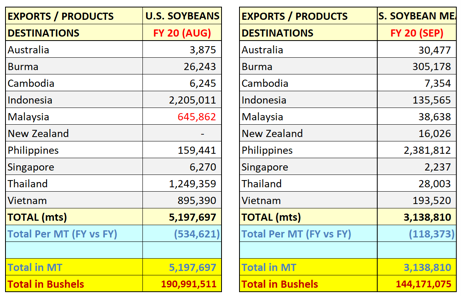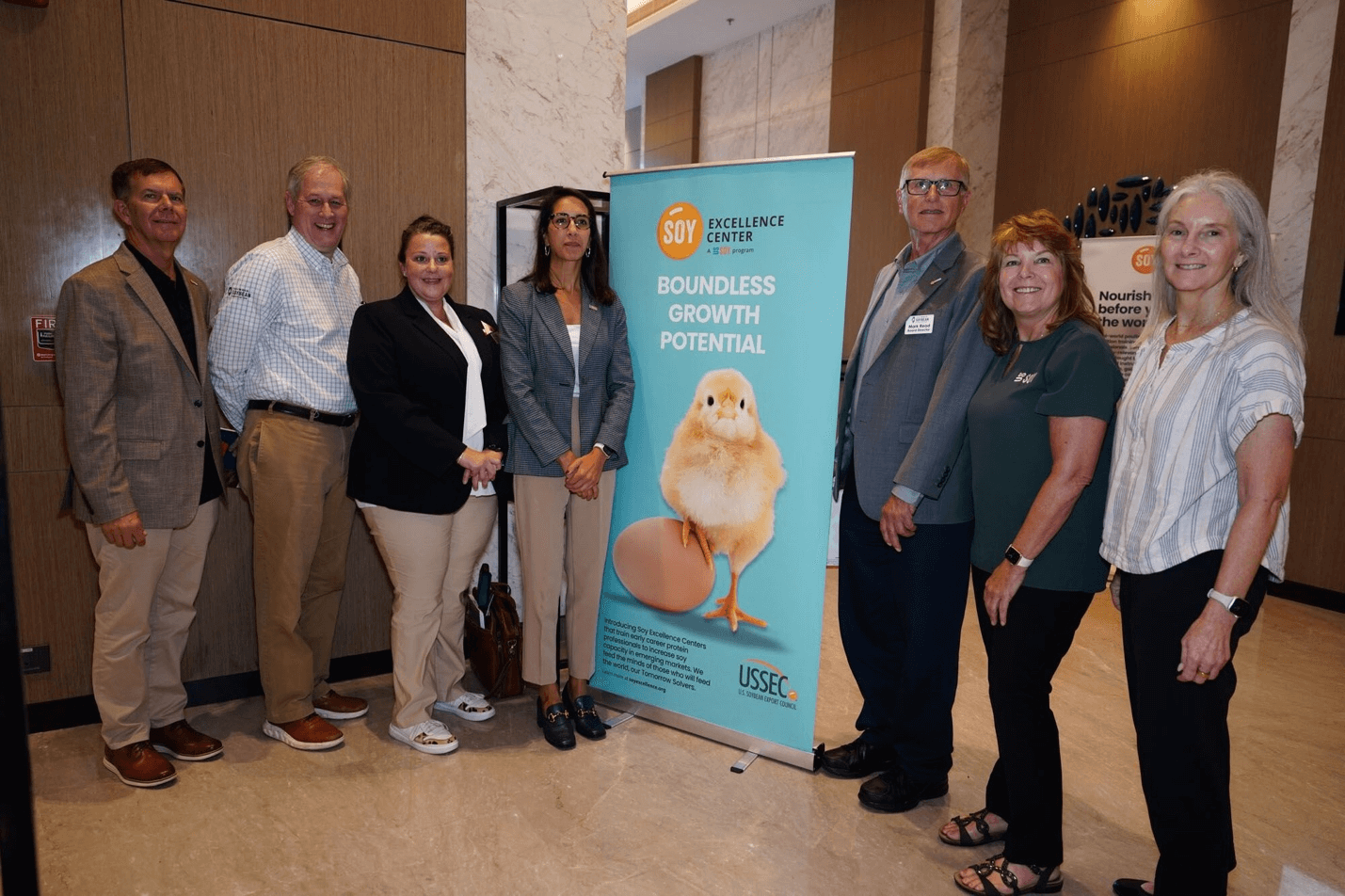By Sarah Salinas
Share
By Sarah Salinas
Share
When people look back on 2020, like many things, they will remember the good and the bad. However, the one thing that nearly all of the experts agree on is that 2020 has accelerated the advancement of virtual technology and remote work. The USSEC team certainly harnessed the power of virtual technology to continue their work and advance the mission.
While many were disappointed by the lack of face-to-face meetings with buyers and stakeholders around the world, Focus Area Director of Market Development Karey Claghorn said our teams around the world were resilient and continued to find ways to implement the work on behalf of U.S. Soy farmers.”
USSEC helps build a preference for U.S. soybeans through a global network of international offices, and these are their highlights:
- Regional Director of Greater China, Xiaoping Zhang notes China’s “continued expansion of the poultry sector in 2020 after last year’s devastating African swine fever,” “the fast demand increase for processed or half-processed seafood from online shops and supermarkets,” “the closer cooperation and interaction among all the sectors in the chain such as production, feed milling, and product processing,” and how the U.S. Soy industry “stood out as locally produced food bean prices skyrocketed amidst an increased production and stable to slight increase in consumption.” Zhang states that China’s soybean meal consumption has maintained a high growth rate, and the outlook is optimistic. Looking into the future, Zhang says “with the development of China’s economy, the promotion of urbanization and the continuous improvement of living standards, China’s consumption of meat, eggs and milk will continue to grow steadily, which will further drive the growth of soybean meal demand.”
- Regional Director of South Asia and Sub-Saharan Africa, Kevin Roepke first provides an overview of 2020 in South Asia, “despite COVID, Bangladesh saw incredible demand for U.S. soy imports, essentially doubling from last year and marking a new high. The country also blessed us with an “early Christmas present” by eliminating tariffs for soybean meal, which led to free market access and immediately paid dividends in the form of U.S. sales. Meanwhile, Bangladesh displayed a strong preference for the safety of the U.S. supply chain, as they doubled their imports of U.S. soybeans, despite COVID-19.” As for Sub-Saharan Africa, “2020 brought about the launch of the Soy Excellence Center in Nigeria. The event marked a landmark moment for USSEC market development in Sub-Saharan Africa. The Center will be the foundation for technical and trade servicing, as well as building capacity within the continent and making the leaders of tomorrow. Moreover, USSEC partnered with WISHH and the U.S. Grains Council to host the first ever Africa Trade Exchange, which was designed to highlight the region to US exporters, as well as introduce Sub-Saharan Africa importers to the USSEC members.”
- Regional Director of the Americas, Carlos Salinas says that what stood out most in 2020 was “the resilience of USSEC, U.S. Soy and the Americas region. Despite of COVID-19 and struggling economies globally, U.S. Soy exports were record breaking. The Americas region also performed well. This increase in exports was also accompanied by a significant market rally, demonstrating the value of the U.S. Soy has to world markets and the importance of USSEC’s mission.” Salinas also pointed out “the excellent execution of the America’s Conference which included some of the highest caliber speakers in the market addressing all the current issues of interest to our customer base.”


AM6
While Salinas and his team were disappointed with the new work from home lifestyle and virtual business practices, they were able to stay on track and have some fun during their Christmas Zoom party.
- Regional Director of North Asia, Rosalind Leeck points out the U.S. Buyers Outlook Conference, the SSAP public relations campaign, and the U.S.-Japan Partnership Team as North Asia’s regional highlights in 2020. First, the U.S. Buyers Outlook Conference was held via Zoom. Leeck said, “nearly 300 joined a combined conference of crushers, feed and food industries in NA region. Info on new crop quality, supply and demand, sustainability, identity-preserved food bean, and dare-to-compare messaging were addressed.” Second, she explained the SSAP public relations campaign, “USSEC Japan implemented a series of PR campaign on SSAP in partnership with one of Japan’s leading media, aiming to maximize recognition of SSAP among Japanese consumers,” resulting in Japan reaching 80% of total U.S. Soy imports. Lastly, USSEC Japan organized a U.S.-Japan Partnership Team virtually to “exchange information and discuss recent U.S. Soy situation and JP vegetable oil market including High Oleic Soybean Oil, sustainability, and China soy outlook.” The event was successful as “several grower leaders, USSEC CEO as well as 30 key industry leaders from JOPA and JOFIEA joined the event.”
- Regional Director of Southeast Asia, Timothy Loh says what stood out most in 2020 was “the resilience of the Food, Ag and livestock industry in Southeast Asia. Despite the impact of COVID-19, African Swine Fever, Biotech and MRL issues, U.S. Soy exports to Southeast Asia was still strong in relative terms.” He also acknowledged his team’s determination and tenacity in the pivot to virtual platforms. In fact, Loh says USSEC Southeast Asia implemented “150 virtual events, both large and small, regional, inter-regional and worldwide; reaching by our estimate an audience of roughly 6,000-7,000.” Lastly, he shows how U.S. Soy exports to the countries listed in the image below “is indicative of the positive impact for U.S. Soy that USSEC and other stakeholders are making for our industry.”

- Regional Director of Europe and Middle East/North Africa, Brent Babb said his team “Zoom’d through 2020 with dozens on customer webinars directly reaching over 20,000 customers. Webinars highlighted the advantage of U.S. soy’s nutritional value and sustainable production. U.S. soy on average has a carbon footprint 10-15 times less than South American soy.” More specifically for the Middle East North Africa region, he says “imports of U.S. Soy continue to expand as local crushers increase use of U.S. soybeans. U.S. soy exports to the region totaled over 5.5 million tons (200 million bushels). Egypt is now the U.S. third largest soybean market. Lastly, Morocco, Algeria, Tunisia, Saudi Arabia also continue to increase imports of U.S. soy.”
265 Comments
Leave A Comment
You must be logged in to post a comment.






Good and inspiring one.
Years upon years, USSEC is growing stronger
Great job
Cool 👍
🙌🙌